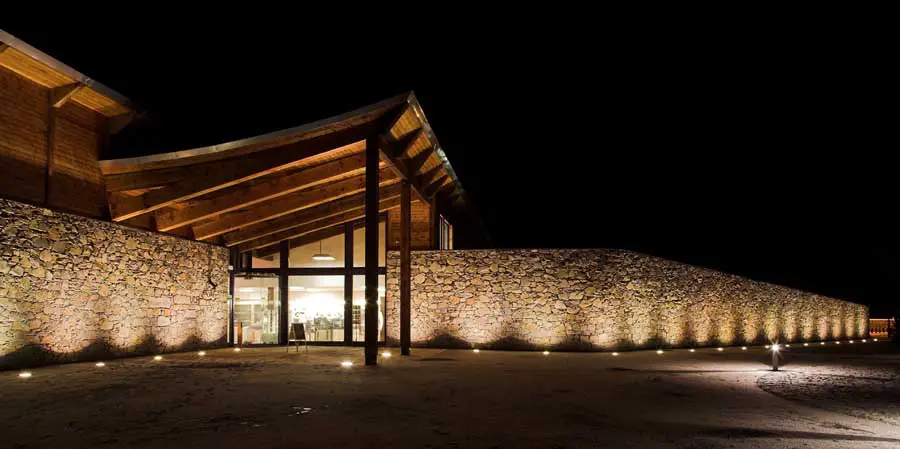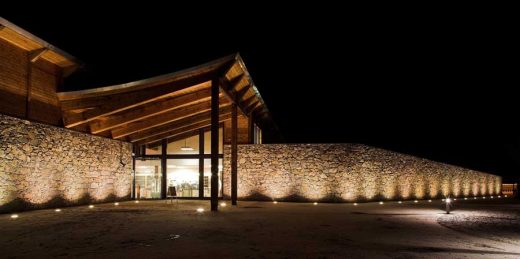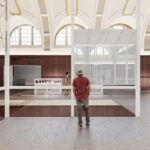Burns Museum Scotland Alloway, South Ayrshire Building News, National Trust for Scotland, Scottish Architect Design
Robert Burns Museum, Scotland : Alloway Building
Birthplace in Alloway design by Simpson & Brown Architects
post updated 10 July 2025
The new Robert Burns Birthplace Museum is open to the public. It is arranged around a 500 sqm exhibition gallery displaying many of the 5000 artefacts in the Museum’s collection, each one telling in a lively and informative manner about Robert Burns’ life, inspiration, fame and identity.
The new Burns International Museum building also accommodates a café opening onto the beautiful mature gardens inherited from an earlier exhibition building, a gift shop and an attractive and welcoming Education Room.
22 Dec 2010
The Robert Burns Birthplace Museum

photos : National Trust for Scotland Photo Library
The new Robert Burns Birthplace Museum plays a central part in the master plan for what used to be known as the Burns National Heritage Park. This master plan was developed to link together and enhance the experience of the different sites in Alloway (Burns Cottage, Burns Monument, Brig O’ Doon and the Auld Kirk amongst others) relating to the poet’s life and legacy and to weave together more closely the threads telling the story of his life, his work and his heritage.
At the North end of the Village the land around the cottage into which Robert Burns was born, has been landscaped so that the adjacent field, which formed the small-holding providing the family with their own food and a small income, has been brought in closer to the cottage, reinforcing the relationship between the dwelling and working land. The old, 1906, museum sharing the site with the Cottage has been converted into an education facility comprising three elegantly detailed function rooms and a library.
A new reception and ticket building has been introduced between the car park and the entrance to the site. The existing walkway bordering the main road and linking the Cottage Site at the north end of the village and the new Burns International Museum site at the south end, has been enhanced with the addition of interpretative installations including a large-scale bronze mouse statue and weather vanes. New access points have been provided onto the path and it has been straightened and made more direct by the addition of a new timber arch footbridge over the old railway line – now part of the national cycle network – that used to cut off the Museum site from the walkway.
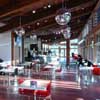
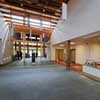
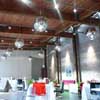
photos : Simpson & Brown Architects
The Design Team agreed early on with The National Trust for Scotland that the new museum building should be designed to be as ‘green’ as was financially possible, and that its ecological features would be an exemplar for other Museum projects, other National Trust for Scotland projects and would be a selling point in their own right. The sustainable agenda for the new museum has been achieved through the design of passive architectural systems, maximizing the use of natural, minimally processed materials, and the careful integration of relevant modern technology. This ‘green’ agenda was an integral part of the conceptual process and evolved alongside considerations about space making and the aesthetic for the building.
The new museum building is set out at the intersection of two primary layout lines. The first line, crossing the site from East to West, forms the boundary between the public space and the private space, which is accessible through the museum building only. The boundary is expressed by a striking, long dry stone wall, rising from each end and folding into the main entrance of the building where it meets the second layout line. The second line crosses the site from North-west to South-east. This defining line in the design emphasizes and symbolises the connection of the new museum with Burns Cottage. It extends from the axis of the new footbridge and cuts through the reception hall and the café of the museum, leading towards the mature gardens.
Behind the dry stone wall, the new museum is housed in a structure entirely made of timber, most of which was sourced locally, as this has the lowest carbon footprint of all materials. The public spaces including the entrance court, the reception hall and the café are defined by a substantial green Douglas-fir structure developed in close collaboration with structural engineers, Buro Happold and Carpenter Oak and Woodland’s workshop in Angus. The rest of the building is made of European redwood panels, with the window frames assembled by Transition Interiors in Kilmarnock. The external wall panels are filled with 250mm of recycled paper (cellulose) which not only gives excellent thermal insulation and reduces the energy consumption of the building but also enhances the hygroscopic quality of the structure, allowing the building envelope to release excess of moisture from within the rooms and the structure to the outside environment.
The layout results from two square plans, interlocking along the link axis to the Cottage. The first square contains the main and ancillary galleries, the collections store and the curatorial offices. The second square wraps round the first and provides space for reception and ticketing, two shops, the café/restaurant, and the Education Room.
The whole structure, apart from the predominately glazed South-east elevation, is clad with untreated Scottish Douglas-fir horizontal boards sourced and processed in Moray, but each square plan is crested by a sweeping curve of green roof. The intertwined relationship of both curves makes for an exciting silhouette. The plant sown on the roof is a succulent plant called sedum, which will help reduce the water run-offs from heavy precipitations and cool the atmosphere above the building during the summer, while requiring a minimum maintenance.
The main Gallery occupying the major part of the first square plan has been designed as open plan black box. The black box quality of the space has offered absolute control to the exhibition and lighting designers over the way the artefacts are presented to the visitors, while the openness of the plan will allow the National Trust for Scotland to easily re-model the exhibition at a later date if they wish to do so. An interesting feature of the main gallery is its climate control system. The air filling the gallery space circulates by natural convection, or ‘chimney stack effect’ assisted by fans when required.
It is sucked in through an air intake structure located in the garden of the museum, and finds its way towards the building through a labyrinth of five large concrete pipes, each 30 m long, buried two meters below ground, and so benefiting from the constant temperature of the ground at this depth; this warms up the incoming air in winter and cools it down in summer. This naturally tempered air enters the building via a basement plant room where additional cooling or warming is provided by the ground source heat pump system installed under the new car park on the North-east side of the site. The air is then passed through another set of pipes, distributing it evenly in the plenum below the Main Gallery space. A portion of it is expelled through the high-level vent grilles below the roofline while the rest is being re-circulated to the plant room. The latter process allows for a better control of the humidity content and for a reduction in heating input.
The ground source heat pump also provided heated water for the under floor heating system in the public spaces. In contrast to the inward looking, blacked out environment of the Main Gallery, the reception hall and the café are very much opened to the outside world and to each other, and take advantage of natural ventilation and natural lighting. The hall is mainly a double storey height space, with the sweeping curve of the roof emphasized by a spine of Douglas-fir purlins that leads the eye from the Reception Hall towards the Café. Each side of the main volume is flanked with lowered ceiling areas sheltering on one side the souvenir shop and the other, the reception desk and the entrance to the gallery. The transition to the Café space is done between two tall glazed screens, and while the spine of Douglas-fir purlins continues through to the glazed screen opening onto the gardens, the character of the café transpires from the imposing structural timber frame, the rows of floating silver light globes that extend on each side of the central section, and the views out to the mature gardens. An external seating area is provided along the south face of the building under a matching timber pergola.
Simpson and Brown Architects acted as the lead consultant for the construction of the new Robert Burns Birthplace Museum, for the repairs to the Birthplace Cottage, for the repair and conversion of the old, 1906, Museum into an attractive and inspirational Education Centre and designed the reception and ticket building at the entrance to the cottage site.
Simpson and Brown won a limited invitation design competition in late 2006. The base build contract value was £9.8 million and ran from January 2009 to December 2010. An additional £ 1.8 million was spent on the fitting out of the exhibition in the Main Gallery under the direct supervision of Event Communications Ltd.
The Robert Burns Birthplace Museum – Building Information
Design Team Leader and architects: Simpson & Brown Architects of Edinburgh
Exhibition & Interpretive Designers: Event Communications Ltd of London
Landscape Architects: Peter McGowan Associates of Edinburgh
Structural Engineers – Services Engineers: Buro Happold, Glasgow office
Lighting Designers: Full-On Lighting Design of London
Archaeologists: Addyman Archaeology, a division of Simpson & Brown Architects
Quantity Surveyors and cost consultants: Morham & Brotchie of Edinburgh
Project Managers: Capita Symonds, Glasgow office
Main Contractors: Border Construction Ltd. of Carlisle
The Robert Burns Birthplace Museum images / information from Simpson & Brown Architects
The Robert Burns International Museum
Alloway, Ayrshire
2007-10
Simpson & Brown Architects
The first stage of the £13 Million Robert Burns Birthplace Museum project in Alloway was completed at the end of the year of Homecoming, an occasion marked by an official visit by the First Minister for Scotland, Alex Salmond.

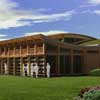
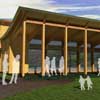
images : Simpson & Brown Architects
The work so far has included extensive roof repairs to Burns Cottage (now reopened with a new interactive exhibition), the construction of a new Ticket Office and Reception Building at the entrance to the site and the restoration of the old 1906 museum into an Education Pavilion housing activity areas, shop, library and office.
Construction of the New Museum is continuing adjacent to the existing Tam O’ Shanter Experience. The new Museum will open to the public during the autumn of 2010.
Robert Burns International Museum images / information from Simpson & Brown Architects
Robert Burns Museum – Building Information
Approx. building cost: £17m
For the National Trust for Scotland
Previously the Burns Museum design was by Sutherland Hussey Architects
Burns International Museum by Sutherland Hussey : Previous Proposals
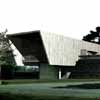
image : SHA
Burns Museum architects – Simpson & Brown
Location: Alloway, south west Scotland
Architecture in Scotland
Contemporary Scottish Architecture
Scottish Architecture Designs – chronological list
Ayr Riverside Office Buildings
Architects: Keppie Design ; Masterplan by Niall McLaughlin Architects
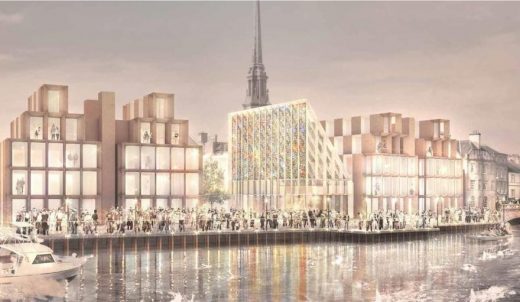
image courtesy of architects
Abbotsford, Scottish Borders
Comments / photos for the Robert Burns Birthplace Museum page welcome
Location: Robert Burns Birthplace Museum Scotland

